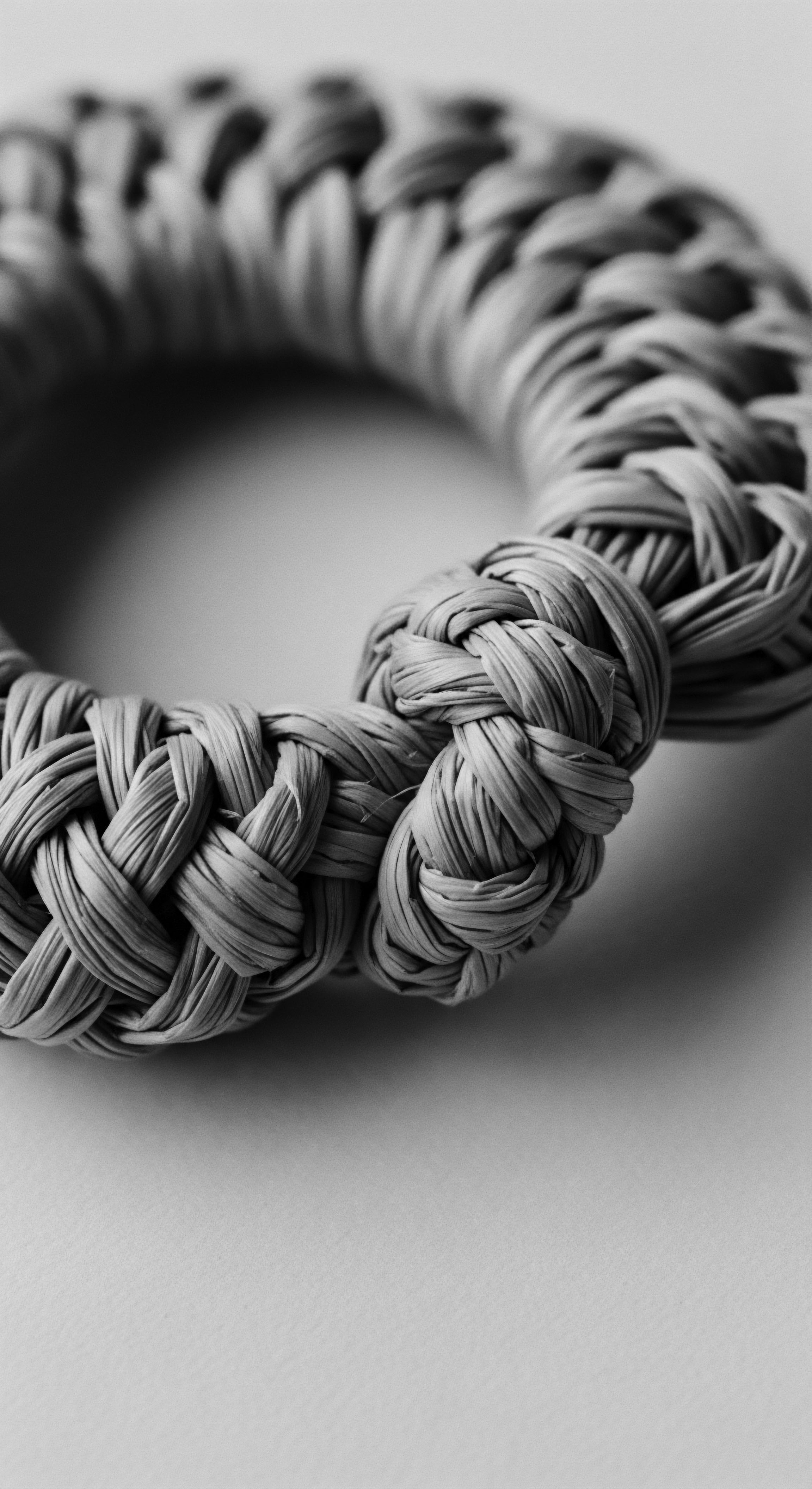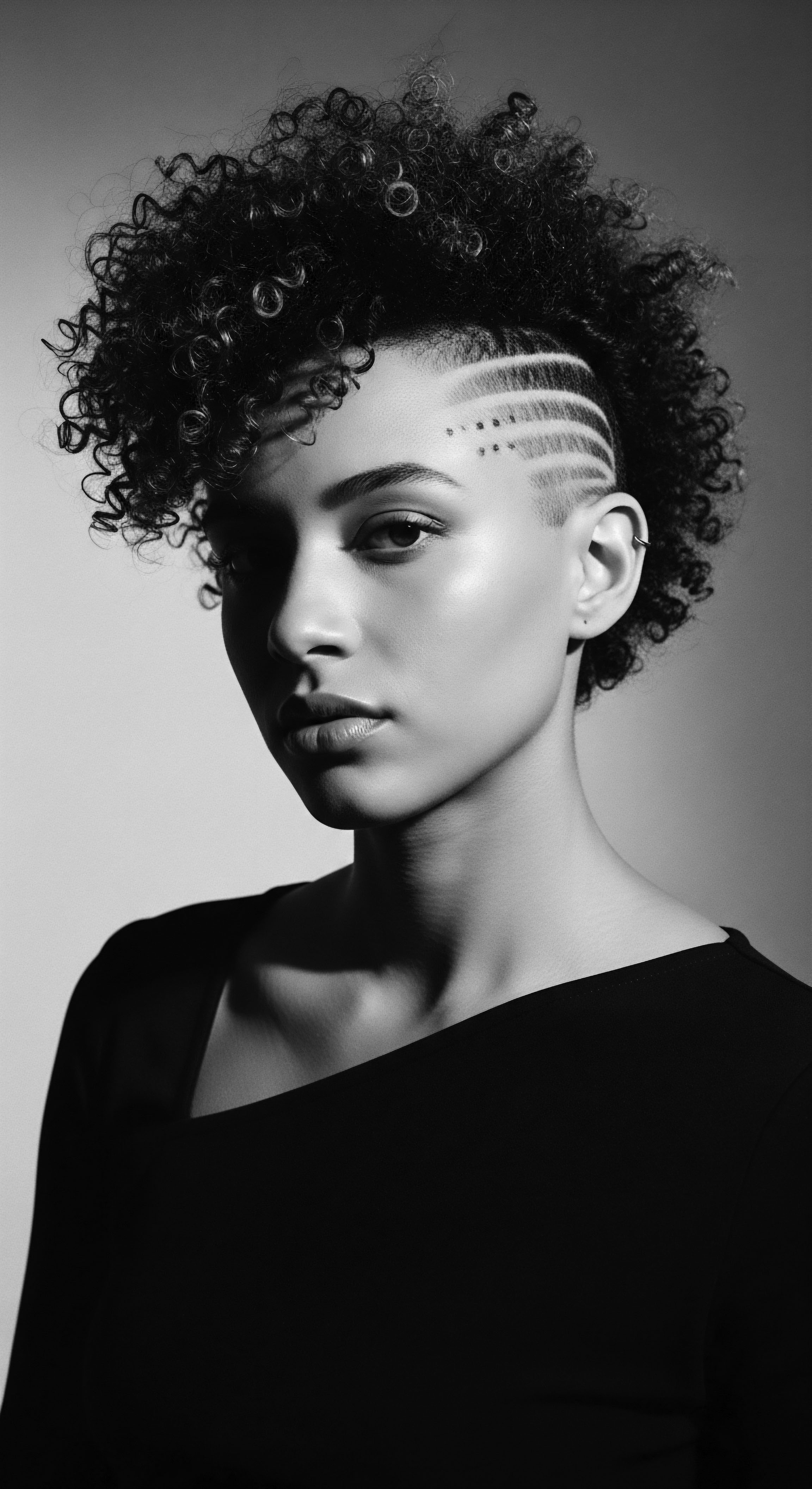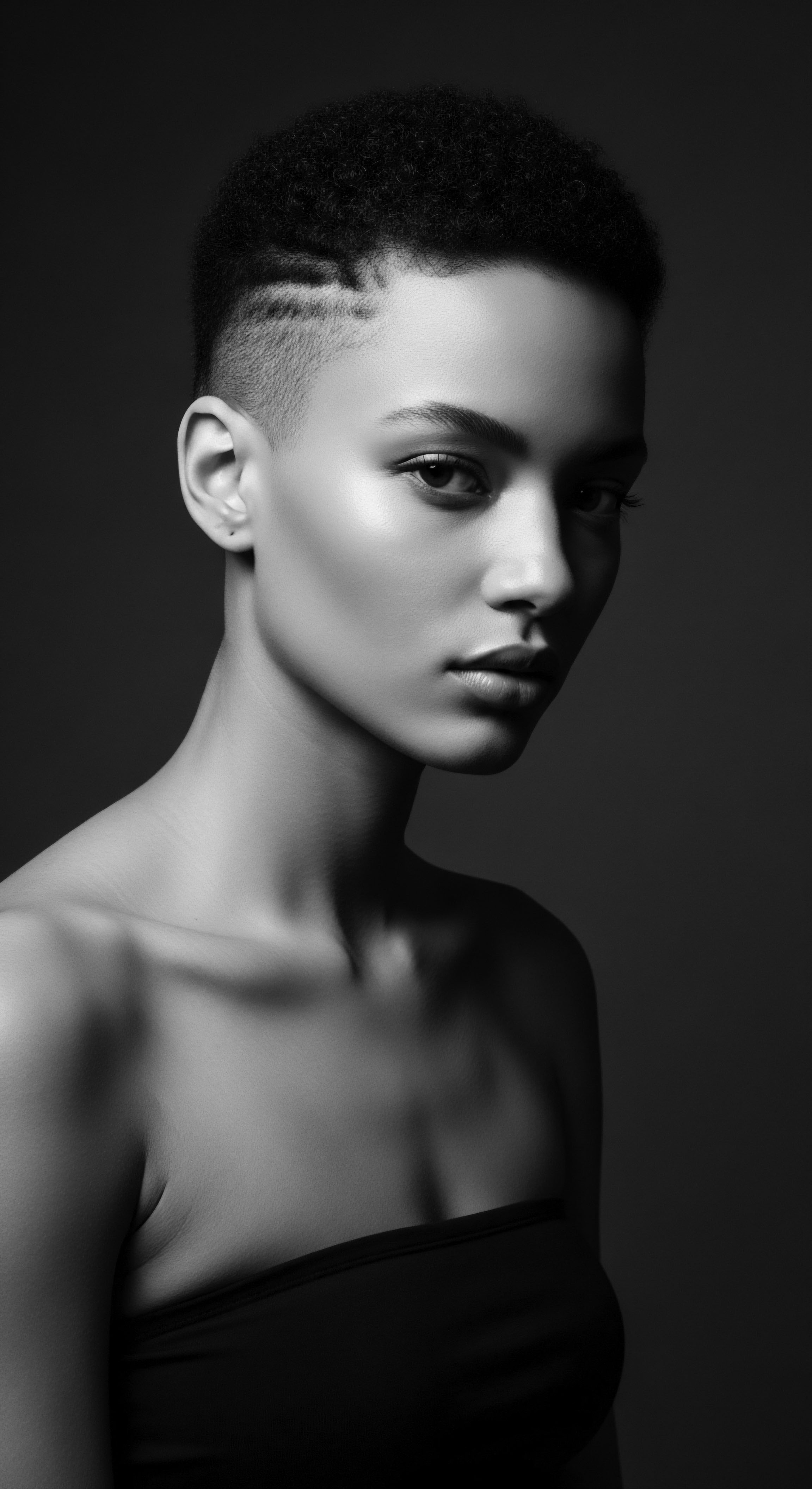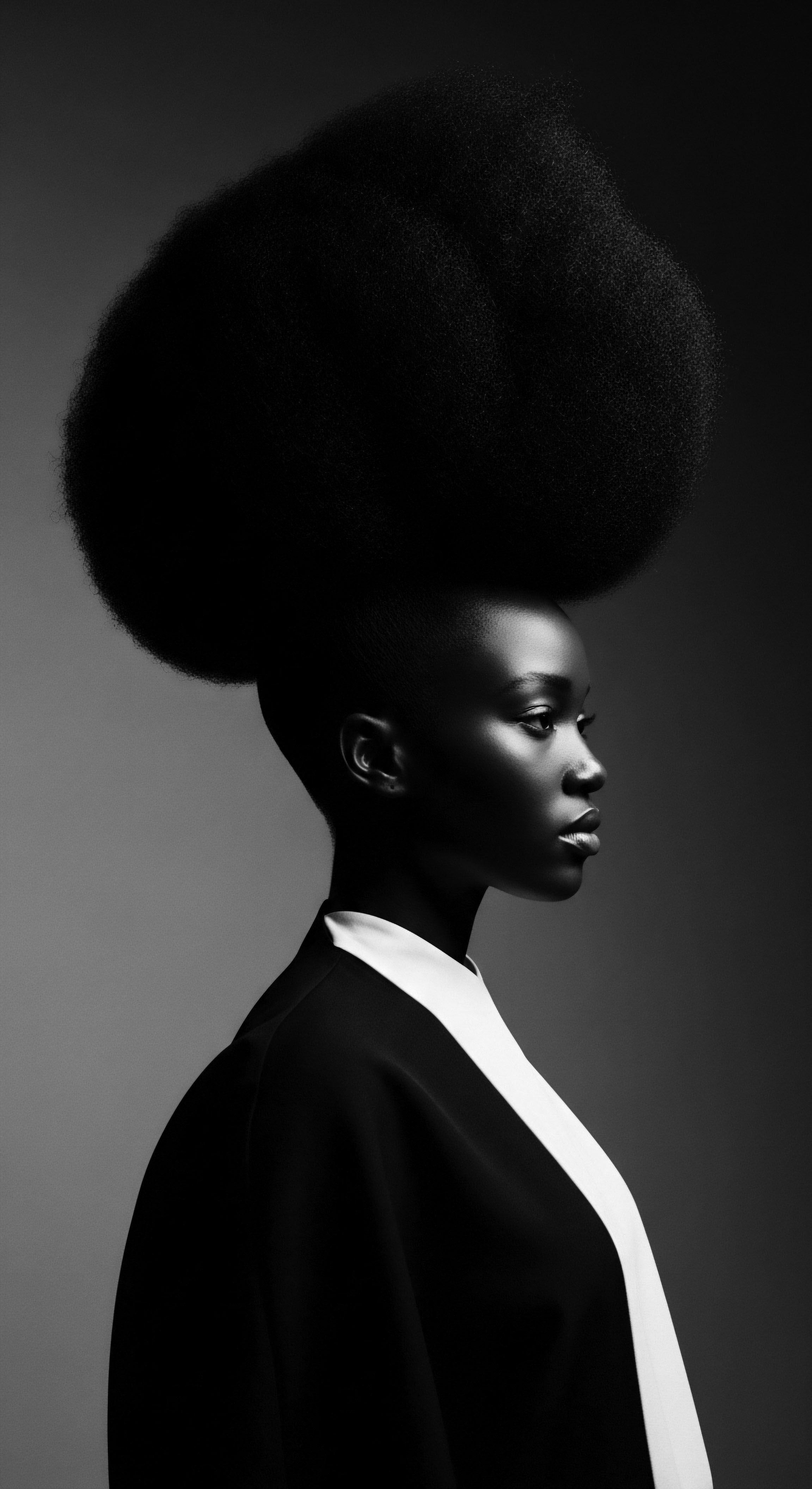Hair, in its wondrous forms, carries echoes of epochs long past, murmuring stories of kinship, belief, and enduring spirit. For those with coiled strands, bountiful waves, or tightly bound curls, the daily tending of hair can reach far beyond mere physical presentation. It becomes a resonant act, a quiet conversation with ancestral voices, weaving present moments into the profound fabric of textured hair heritage. This exploration considers how these ritualistic care practices can deepen a spiritual connection to that very lineage.

Roots
There exists a whisper, ancient and persistent, within each curl, a memory tracing back to elemental biology and the earliest human traditions. This connection to hair’s natural form, honored by those who lived with reverence for the earth and its creations, represents a true beginning for understanding textured hair heritage. The biological structure of these strands, with their unique coil patterns and follicular structures, are not random occurrences but rather gifts passed down through generations, shaped by the very environments and needs of those who came before us.

The Anatomy and Ancestral View of Coiled Hair
To grasp the heart of textured hair is to appreciate its unique architecture. Unlike straight or wavy hair, coiled strands exhibit an elliptical follicle shape and a distinctive growth pattern that creates varying degrees of curl, from loose waves to tight coils. This morphology provides particular strength and elasticity, yet also makes it prone to dryness and delicate handling. Ancient communities, without the benefit of microscopes or chemical analysis, possessed an intuitive understanding of these properties.
They observed, learned, and devised care strategies that worked in harmony with the hair’s natural inclination, not against it. This deep, observant knowledge forms the foundation of ancestral hair care. Early societies often viewed hair as an extension of the soul, a conduit for spiritual energy. In many African cultures, the highest point of the body, the head, was considered sacred, a gateway to the divine and a vessel for ancestral communication (Mbilishaka, 2018a). This perspective elevated hair from a simple biological feature to a profound spiritual symbol, demanding respectful care.

Early Classifications and Cultural Expression
The systems of hair classification we use today, while a modern attempt to categorize varied textures, have roots in a long human history of observing and distinguishing hair types. In ancient African societies, hair classifications were not solely based on curl pattern but on far more intricate social and spiritual markers. A person’s hairstyle could communicate age, marital status, social standing, religious belief, and even tribal affiliation. The elaborate designs were not merely decorative; they functioned as a nonverbal language, broadcasting identity within communities (Byrd & Tharps, 2014).
This early, organic form of classification was deeply embedded within the social structure, underscoring hair’s central role in communal life. It speaks to a time when hair was a living archive, conveying a person’s entire lineage and place in the world.
Hair, when understood through the lens of heritage, becomes a profound archive, each strand holding ancestral whispers.

The Essential Language of Textured Hair in Heritage
The words used to describe textured hair and its care have evolved over centuries, reflecting shifting societal views and enduring cultural practices. In ancestral communities, specific terms designated hair types, styling techniques, and the very tools employed. These terms were often tied to the land, the spirits, and the collective history of the people. For example, the Yoruba people of Nigeria would braid their hair to send messages to and communicate with their gods and goddesses, implying that hair care was not only for outer appearance but also for inner spirituality (Shedavi, 2023).
This intertwining of practical action and spiritual purpose is a hallmark of heritage-bound hair practices. Learning and using these traditional terms, even in translation, connects one to the historical context of these rituals.
- Shuku ❉ A Yoruba braided crown style, often rising at the head’s center, symbolizing status.
- Nontombis ❉ For the Xhosa, specific braids indicating life events.
- Otjize ❉ A red ochre paste mixed with fat, used by the Himba people of Namibia to protect and style their locs, symbolizing connection to earth and ancestors.

Cycles of Growth and Environmental Resonance
Hair grows in cycles ❉ anagen (growth), catagen (transition), and telogen (rest). While modern science maps these phases with precision, ancient civilizations understood hair’s connection to natural cycles and environmental influences. The health of one’s hair was often seen as a reflection of overall well-being, deeply linked to diet, climate, and the available natural resources. Ancestral hair care often involved ingredients sourced directly from the land—oils from native plants, herbs for cleansing, and butters for moisture.
This ecological harmony reinforced the belief that hair was a living entity, deserving of respect and nourishment from its natural surroundings. The cyclical nature of hair, its shedding and renewal, mirrored the cycles of life and death, reinforcing its connection to the spiritual realm and the continuum of generations.
Consider the historical application of natural elements for hair health, often tied to ritualistic beliefs:
| Traditional Ingredient/Practice Shea Butter (West Africa) |
| Associated Cultural Significance/Benefit (Historical) Protection from sun, moisture for arid climates, spiritual anointing. |
| Modern Scientific Link (Contemporary) Rich in fatty acids and vitamins A and E, excellent emollient for hair shafts. |
| Traditional Ingredient/Practice Chebe Powder (Chad) |
| Associated Cultural Significance/Benefit (Historical) Hair length retention, strength in nomadic communities, cultural identity. |
| Modern Scientific Link (Contemporary) Likely works by coating and sealing the hair, reducing breakage. |
| Traditional Ingredient/Practice Ayurvedic Herbs (India, sometimes adapted by diasporic communities) |
| Associated Cultural Significance/Benefit (Historical) Balance of doshas, spiritual purification, scalp health. |
| Modern Scientific Link (Contemporary) Many herbs possess anti-inflammatory, antimicrobial, or strengthening properties. |
| Traditional Ingredient/Practice Oil Rinsing (Various African cultures) |
| Associated Cultural Significance/Benefit (Historical) Scalp stimulation, cleansing, spiritual cleansing before ceremonies. |
| Modern Scientific Link (Contemporary) Improved blood circulation, removal of product buildup. |
| Traditional Ingredient/Practice This table highlights how age-old practices, born of necessity and spiritual belief, often align with present-day scientific understanding of hair wellness, solidifying the wisdom held within heritage. |

Ritual
The act of caring for textured hair has long been imbued with purpose beyond mere grooming. It transforms into a ritual, a tender thread connecting individuals to community, to shared wisdom, and to the enduring spirit of their heritage. These practices, passed down through the gentle hands of elders, become living traditions, each stroke and application a quiet affirmation of belonging and remembrance. This intimate exchange, often conducted in communal settings, reinforces bonds and transmits cultural knowledge across generations, particularly within Black and mixed-race communities.

Ancestral Roots of Protective Styling
Protective styles, such as braids, locs, and twists, hold a profound place in the heritage of textured hair. For centuries, these styles offered practicality—guarding delicate strands from environmental harshness and promoting length retention. More significantly, they were cultural markers, intricate expressions of art and identity. In ancient Africa, complex braiding patterns communicated a person’s marital status, age, wealth, and even tribal affiliation (Byrd & Tharps, 2014; OkayAfrica, 2023).
The process of creating these styles was a communal event, hours spent together fostering social bonds, sharing stories, and transmitting wisdom from elder to youth (Shedavi, 2023). This communal aspect itself was a ritual, a space for shared experience and cultural continuity.
Consider the historical significance of various protective styles:
- Cornrows ❉ Beyond their practical purpose, cornrows, with their tight, scalp-hugging patterns, served as covert maps for escape routes during the transatlantic slave trade. Enslaved women would embed seeds within their braided designs, carrying vital resources for survival and future cultivation upon reaching freedom (OkayAfrica, 2024; University of Salford Students’ Union, 2024). This historical example powerfully demonstrates how a hair care ritual transformed into a tool of survival and resistance, a profound act of defiance and hope against overwhelming oppression.
- Bantu Knots ❉ Originating with the Zulu people of Southern Africa, these coiled, knot-like styles were not just a form of curl definition but also a cultural statement, reflecting status and beauty.
- Locs ❉ Beyond their more modern associations, matted hair forms have spiritual connections in various cultures, notably seen in some Rastafarian communities as a conduit for spiritual energy and connection to the divine (Waldstein & Waldstein, 2016).

Does Daily Care Mirror Ancient Hairstyling Customs?
The daily ritual of natural styling and definition techniques, from finger coiling to twisting, can indeed mirror ancient hairstyling customs. The very act of manipulating textured hair with intention, separating strands, applying natural concoctions, and shaping it, echoes the methodical care practiced by ancestors. These methods, often passed down through families, reflect an intuitive understanding of the hair’s coiled structure and its need for specific handling.
The use of natural ingredients, whether traditionally wild-harvested botanicals or thoughtfully sourced modern alternatives, grounds the practice in a sense of ecological connection that harkens back to earlier times when humans lived in closer harmony with their environment. The patience required for these practices is a link to the past, when hair care was not rushed but rather a dedicated, often social, event.

The Tools of Tradition and Their Echoes
The instruments used for textured hair care, from wide-tooth combs to specific adornments, also carry historical weight. Traditional tools, often crafted from wood, bone, or natural fibers, were not just functional implements; they were often imbued with cultural significance. In ancient Egypt, combs made of wood or ivory were used for gentle detangling, reflecting a belief in delicate hair handling (Rthvi, 2024).
The adornments—beads, shells, cowrie shells, gold—were more than decorative elements; they were symbols of wealth, status, and spiritual protection (OkayAfrica, 2023; Assendelft, 2024). When we choose a wooden comb over plastic, or decorate our styles with culturally resonant elements, we are, in a quiet way, engaging with a lineage of care and artistic expression that stretches back across centuries.
| Historical Tool/Material Wide-Tooth Wooden Combs |
| Traditional Application/Significance Gentle detangling, scalp stimulation; crafted from natural resources. |
| Modern Equivalent/Influence Plastic or bamboo wide-tooth combs; emphasis on minimal breakage. |
| Historical Tool/Material Natural Plant Fibers |
| Traditional Application/Significance Extensions for length and volume; integrated into styles for cultural messaging. |
| Modern Equivalent/Influence Synthetic or human hair extensions; used for protective styling or stylistic variations. |
| Historical Tool/Material Clay/Ash Pastes |
| Traditional Application/Significance Cleansing, detoxifying, scalp treatment; often for specific rituals. |
| Modern Equivalent/Influence Bentonite clay masks, apple cider vinegar rinses; natural detox methods. |
| Historical Tool/Material Beads, Cowrie Shells, Gold Adornments |
| Traditional Application/Significance Symbol of wealth, status, marital status, spiritual protection; personal storytelling. |
| Modern Equivalent/Influence Decorative hair jewelry, clips, wraps; personal expression and cultural affirmation. |
| Historical Tool/Material The enduring presence of these functional and symbolic elements in hair care bridges vast spans of time, showing how traditional ingenuity continues to inform contemporary practices. |

Relay
The journey of textured hair is a relay, a sacred passing of the torch from one generation to the next, each touch, each technique, each whispered word a continuation of a profound heritage. The rituals of care are not static relics of the past; they are living, breathing expressions of identity, resilience, and an enduring connection to ancestral wisdom. Through this lens, the daily tending of hair becomes a spiritual practice, a dialogue with those who came before, shaping the present and influencing the future. This is where the core of the exploration reveals itself ❉ how these practices serve as a conduit for spiritual connection to one’s lineage.

How Do Hair Care Rituals Serve as a Link to Ancestors?
Hair care rituals often serve as a tangible link to ancestors through their deep roots in communal practice and inherited knowledge. Consider the shared experience of braiding or oiling hair, traditionally performed by mothers, aunts, or respected elders. This exchange, often a quiet time of storytelling and connection, transmits more than just technique; it passes down historical memory, cultural values, and a sense of belonging (Shedavi, 2023; Khumbula, 2024). The Yoruba people, for instance, held the head as the most sacred part of the body, believing it to be the seat of power and intellect, directly connecting to the divine.
Hairstyles were chosen with spiritual intention, some used to send messages to the gods (Byrd & Tharps, 2014; Shedavi, 2023). When contemporary individuals engage in these inherited rituals, they are not simply grooming; they are participating in an unbroken lineage of cultural and spiritual practice, honoring the traditions that sustained their forebears. The physical act of caring for hair becomes a meditative one, opening space for reflection and a quiet acknowledgement of the continuous presence of ancestral spirit. This connection is not abstract; it is felt in the familiar motions, the scents of natural ingredients long used, and the shared understanding that this hair, in its unique texture, is a living testament to heritage.
The simple act of hair care transforms into a spiritual practice, a quiet communion with ancestral wisdom.

Hair as a Marker of Identity and Spiritual Status
Across countless African societies, hair acted as a potent marker of identity, status, and spiritual standing. Specific styles communicated a person’s age, social role, marital status, or even their spiritual initiation or connection to particular deities (Omotos, 2018; Khumbula, 2024; Afriklens, 2024). For the Maasai of Tanzania and Kenya, for instance, adolescent males undergo a ritualistic dyeing of their hair a bright red color and grow long locs as part of their initiation into warriorhood. Only upon completion of their duties may they cut their hair in a community gathering, a symbolic rebirth into the next stage of life (Mbilishaka, 2018b).
This transformation, marked by hair, demonstrates its profound role in spiritual and social transitions. Even during the transatlantic slave trade, when enslaved Africans were often forcibly shorn of their hair—a deliberate act to strip them of identity and cultural connection (Byrd & Tharps, 2014; University of Salford Students’ Union, 2024)—hair became a tool of resistance. Despite immense hardship, individuals found ways to style and protect their hair, reaffirming their humanity and cultural continuity (University of Salford Students’ Union, 2024; Matjila, 2020). These acts of defiance, often done in secret, were deeply spiritual, a way to hold onto self and heritage in the face of brutal erasure. The enduring presence of these styles today—cornrows, locs, twists—are not just fashion; they are living testaments to survival, agency, and a proud reclamation of identity.

Connecting Ancestral Wellness to Modern Practices
Modern hair care, when approached with a heritage lens, often finds surprising alignment with ancestral wellness philosophies. Many traditional practices, rooted in ecological understanding and spiritual reverence, employed natural ingredients for their restorative properties. The application of oils from indigenous plants, cleansing with specific herbs, and styling with natural fibers all speak to a holistic approach to well-being (Rthvi, 2024; University of Salford Students’ Union, 2024). Today, the renewed appreciation for ingredients like shea butter, castor oil, and various herbal infusions for textured hair can be seen as a continuation of this ancestral wisdom.
The scientific understanding of these ingredients often validates what was known intuitively for generations ❉ they nourish, protect, and contribute to overall scalp and hair health. This conscious choice to utilize practices and ingredients that echo ancestral ways transcends superficial beauty; it becomes a deliberate act of reconnecting with a legacy of self-care and an acknowledgement of the deeper, interconnectedness of body, spirit, and the natural world.
The influence of ancestral methods on contemporary regimens extends to the philosophy of care. The patience, the gentle handling, and the recognition of hair as something precious, not merely an accessory, are lessons inherited from the past. For instance, the systematic removal of hair by slave traders upon arrival was not just a hygiene measure; it was a profound act of dehumanization, a symbolic severing of cultural and spiritual ties (Matjila, 2020; University of Salford Students’ Union, 2024). This historical wound makes the modern reclamation of natural hair, and the rituals surrounding its care, particularly potent as acts of healing and self-affirmation.

Reflection
The enduring presence of textured hair care rituals, steeped in generational memory and practice, stands as a testament to their enduring power. These are not simply acts of grooming; they are living archives, each strand, each brush, each twist a whisper of heritage. From the intricate cornrow patterns that once hid messages of freedom during unimaginable hardship, to the communal braiding circles that cemented social bonds and passed down wisdom, the connection between tending textured hair and spiritual lineage is undeniable. This deliberate engagement with ancestral practices allows individuals to feel a continuity with their past, to honor the resilience and creativity of those who came before them, and to reaffirm a sense of self that is deeply rooted in cultural memory.
In a world that often seeks to homogenize or diminish the unique expressions of Black and mixed-race identities, the conscious choice to care for textured hair with reverence becomes a profound act of self-love, cultural affirmation, and a vibrant continuation of a living legacy. It reinforces the simple, yet powerful, truth that within each coil and curl lies the ‘Soul of a Strand’ – a spirit unbroken, eternally connected to its source.

References
- Afriklens. (2024). African Hairstyles ❉ Cultural Significance and Legacy.
- Assendelft. (2024). Pre-Colonial African Hairstyles ❉ A Journey Through Time and Culture.
- Byrd, A. D. & Tharps, L. L. (2014). Hair Story ❉ Untangling the Roots of Black Hair in America. St. Martin’s Press.
- Khumbula. (2024). A Crowning Glory ❉ Hair as History, Identity, and Ritual.
- Matjila, C. R. (2020). The meaning of hair for Southern African Black women. University of the Free State.
- Mbilishaka, K. (2018a). PsychoHairapy ❉ Brushing Up on the History and Psychology of Black Hair. Psi Chi Journal of Psychological Research, 23(3), 253–262.
- Mbilishaka, K. (2018b). The Psychology of Hair. In press.
- OkayAfrica. (2023). A Regional Walk Through The History of African Hair Braiding.
- OkayAfrica. (2024). Cornrows as Codes ❉ Hidden Messages in Hairstyles.
- Omotos, A. S. (2018). The “Dreaded” Colonial Legacy ❉ African Hairstyles. Journal of Pan African Studies, 11(6), 18-35.
- Rthvi. (2024). Exploring Ancient Hair Care Rituals ❉ Timeless Practices for Modern Hair Wellness.
- Shedavi. (2023). History of Black Hair & It’s Hidden Symbolism.
- University of Salford Students’ Union. (2024). The Remarkable History Behind Black Hairstyles.
- Waldstein, A. & Waldstein, B. (2016). Studying the Body in Rastafari Rituals ❉ Spirituality, Embodiment and Ethnographic Knowledge. Journal for the Study of Religious Experience, 2(1), 71-86.
